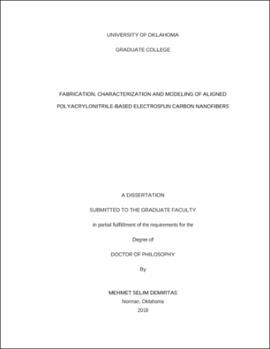| dc.description.abstract | Electrospinning is widely used to produce carbon nanofiber from polyacrylonitrile (PAN). The alignment of fibers may vary depending on electrospinning condition. In this study, an electrospinning setup is developed to fabricate aligned and uniform yarns from PAN, employing an adjustable rotating disc. Effects of relative humidity (RH) on fiber diameter and mechanical properties of electrospun, stabilized and carbonized nanofibers are investigated. Average fiber diameter increases from 365 nm to 602 nm by increasing RH 22% to 60%. Additionally, mechanical properties are reduced by increasing RH. Nanofibers are generated at low RH show poor mechanical properties. 22% RH yields the best mechanical properties.
Collector geometry and rotating speed influence electrospun nanofiber alignment. The nanofiber diameter distribution, porosity, orientation, and mechanical properties are investigated. A unique approach is adopted to test the nanofiber films in tension using a dynamic mechanical analyzer (DMA). Furthermore, 2-dimensional FEM analysis is performed to investigate electric field distribution around the collector. It is observed that the speed of the rotating disc can help improve the alignment of nanofibers in the film. It is also absolved that the electric field is more intense and uniform on the collector surface for wire and mesh type collectors compared to foil collectors. Nanofibers electrospun with wire type collector show the highest alignment due to the intense uniform electric field and tensile properties of carbonized nanofiber films. Electrode geometry is another electrospinning element that influences the fiber alignment. Three different tip electrode systems are investigated; single blind needle, flash needle, where the needle is located in a copper cylinder and completely flush with the edge of the cylinder, and protruded needle, where the needle passes through a copper cylinder and protrudes 0.5 mm past the edge of the cylinder. Similarly, 2D FEM is studied to obtain electric field distribution of the needle region. The alignment and diameter of nanofibers vary by changes in the needle system when all other electrospinning parameters are kept constant. The flash and protruded type of electrode yields more uniform and better fiber alignment. Furthermore, Taylor cone and straight jet formation dependence on flow rate and applied voltage are investigated using a high speed camera. an average fiber diameter of 422 nm is obtained for needle type while 389 nm is obtained for the protruded needle and fiber alignment was also improved with varying electrode types.
Stabilization conditions influence mechanical properties of carbon nanofibers. The effects of hot drawing of electrospun PAN nanofiber yarns and pre-stress during stabilization on the mechanical properties of stabilized yarns is investigated. The as-spun PAN nanofibers are mechanically stretched to stretch ratios (λ) of 1, 2 and 3 at 135 oC and subsequently stabilized at 260°C in air for 180 min under different mechanical pre-stress conditions, up to 5 MPa. Fiber diameter distribution is investigated via SEM, and tensile properties are measured via dynamic DMA. It has been found that stretching significantly improves the tensile strength of electrospun and stabilized fibers, while decreasing average fiber diameter. Pre-stress during stabilization has an important role on mechanical properties. Unstretched fibers show weaker mechanical properties comparing to stretched fibers. A tensile strength of about 401 MPa is obtained for λ=2 produced at 1 MPa pre-stress while stabilizing, compared to about 191 MPa for λ=0.
Determining mechanical properties of a single filament carbon nanofibers is an extremely complicated and requires expensive equipment. A statistical model is developed to determine single filament tensile strength from bundle test. A Weibull statistical model is modified to analysis to estimate tensile strength of single filament electrospun carbon nanofiber from bundle test. The tensile strength is obtained 2.52 GPa where the standard deviation of fiber angle distribution is 2.7o. Tensile strength is calculated 1.66 GPa for standard deviation 15.8o while 2.7o is 2.52 GPa. A relation between Weibull parameters and alignment is obtained from experimental results. Tensile strength and failure strain of 0o standard deviation is calculated from estimated Weibull parameters. | en_US |
